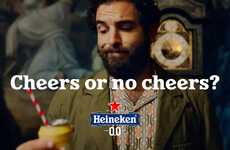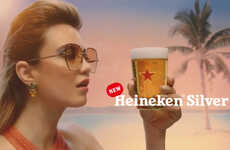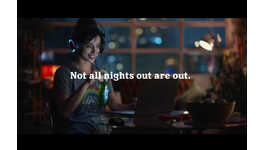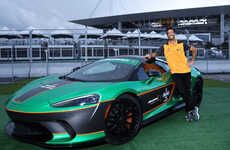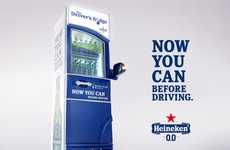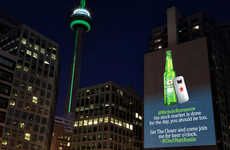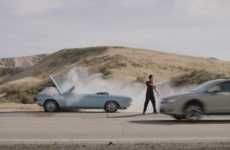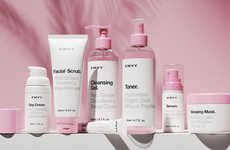Heineken Releases Its New Millennial-Inspired Brand Strategy
Mary Van Puymbroeck — September 12, 2018 — Lifestyle
References: youtube & theheinekencompany
It comes as no surprise that many consumer-facing brands have had to reassess their brand strategy when it comes to communication with socially-aware Millennials. After realizing that their brand strategy was putting too much pressure on Millennials, Heineken decided to rebuild their offering. Trend Hunter sat down with Gianluca Di Tondo, the Senior Brand Director for the Heineken brand at a global level (known by colleagues as Mr. Heineken) to discuss how they've shifted their brand strategy to establish a level of authenticity with jaded Millennials.
Coinciding with the Italian Grand Prix at Monza, Heineken has released an ad featuring Formula One superstar, David Coulthard, and their new brand strategy.
When you’re trying to approach the Millennial demographic, what resources are you using to sort of support your work and address them more confidently?
This is a very good question. In general I’d say everything because TV still plays quite a big role across our market, but of course, the bigger evolution is that digital is getting more important and more interesting. There are markets in which digital lends priority to TV and there are markets where digital is more important than TV and keeps growing. Of course, the beauty of digital is it requires a different type of creativity than is required for what we call hero content. That is, video that can usually be between 30 and 60 seconds and can be used for TV and Youtube. But then out of this hero content, we have a lot of what we call satellite content that has been cut down or is inspired by the hero content 3, 6 or 10 seconds.
And of course, every time that you approach digital whether that's through Instagram, YouTube or facebook, you need to adapt your creativity. Now that we’re getting more and more data driven, the data will inspire the creativity. Because depending on who you are, the digital lens will be different. Depending on which type of typology of person you are, the system will serve you different assets. Of course in hero piece is the same, but then all the satellite and digital assets will be different. So you see the big revolution is that in the past, you were planning media by what I call waves, so say in May we have the Champions League because the final is always then and in Italy, September is Formula One because of the Grand Prix at Monza. So it was very vertically done in these big waves. Tomorrow, you will have waves in TV because it is still driven by the time, but in digital everything will be at the same moment with the difference that if I’m a Formula One fan, I’ll receive content for that, if its rugby, you’ll get Rugby. So all these things can run in parallel
When I took over this position 6 years ago the big job was to deliver TV campaign. Now, TV is a nice piece, but out of one piece of content, sometimes you have 300,000 pieces of digital content. So thats the big revolution that is coming.
How does experientialism play into this new brand strategy, understanding that Millennials as a consumer group are more drawn to experiences over products?
That’s a very good question . So it depends on what you're talking about. When you talk about sponsorships, the experiential part is easier because it's deeply related to the nature of what we’re talking about because Champions League or Formula One or the Rugby World Cup have a very important lens for what we’re doing out there outside of the media strategy. So in that sense, you’ll have another leg that is just digitally related to what we do during the Grand Prix at Monza or doing what we call the trophy tour so moving the trophy around our market and crating small events.
What we’re trying to do differently in 2019 is to always start from the same common believe, the same cliche. It’s sort of a lens that you will apply before everything. So for F1, everything in 2019 will be to help people understand that it’s not a one man band, it’s a team effort and we’re going to start creating experiences for consumers that are in this direction.
The other beautiful thing is now we start pulling creativity from our market. We have our global team working with me in Amsterdam, but we also have a creative team all over the world so what we’ve started to do is ask our markets ‘what is your cliche?’ You are in Chile or you are in Japan and you’re talking about Champions League, what do people think about Champions League because then we can pull out a series of cliches that will inspire the development of the next point of creativity or the next experience.
How did you find out that your former campaign was putting too much pressure on Millennials?
That was through a bunch of research. Every year we test our position. So how is our positioning of the brand resonating with our target consumers from around the world. This is an important step because it gives you the relative position and the relative strengths of your brand compared to the new generation. So we set this as 25-34 and we test all our things, not only this kind of video but the sentence that sits beyond that.
In the past, the challenge of crossing your border sat very well with consumers because it was seen in an inspirational way. The brand always inspired me to always take a step further and to always progress.
But then when Millennials started to pop up and they became our biggest target audience, they really took that as, ‘why are you telling me what to do?’. It's really related to ‘ you must’.
As a young person, I already must do a lot of things and this bothers me. I don’t want to also be bothered by a brand. So everything that you try to do in a light hearted way, in a fun way, was spoiled by this layer of ‘you must think’.
At the beginning, this was hard for us to understand because usually you have cultural differences in the developed market and the developing market. We always try to find the global insight but then try and customize it from these two positions. Today, the difference with Millennials is that they’re very similar. Whether you live in Nigeria or the US, this layer of stress is the same. So when we saw this coming, of course we re-tested because it was quite weird.
But then there was a clear understanding that something was not working. And then you start deep diving and determine its the ‘you must’ piece. But if you remove from the crossing borders piece, ‘you must’ you get a sentence that makes no sense so we decided we needed to rework the positioning all together.
How has Heineken struggled to communicate with the Millennial consumer?
We got the struggle at the beginning to understand them because it was quite a revolution. I’ve been in marketing for twenty years and for the first time you have a target audience that is really different. This notion that its necessary for a brand to align with a purpose and something bigger than themselves has suddenly emerged everywhere and we weren’t expecting this especially in developing markets. It took a bit of time to understand that for the first time you have a global audience that has more things in common than things that make them different. We were so used to having to work hard to find these global insights and points of connection.
To be honest, and this might be kind of controversial, for me the Millennial makes my job easier because its easier to find this common denominator across them. We used to have to split our balance of global and local content evenly. But now in most of the market I can go 80/20.
The global insight, if you crack it well, will resonate everywhere. Then you have 20% localization that digital can tackle very simply, again because it’s all about fine tuning the local persona and determining what resonates well in Italy vs the Netherlands vs Brazil.
But for the first time you can really look for global insight because Millennials and also Gen Z are very very similar.
There’s this perception that Gen Z functions as Millennial-lite in a way. What are some difference that you’ve seen emerge, from a brand perspective, that differentiate the two generations?
I think they are the same kind of typology of personas. Probably for Gen Z, the layer of pressure is even more because they also look at Millennials and say ‘ you didn’t fix anything’. So for me it’s going to be even harder. It’s the same trait, they are not different so we look at them in the same way.
Probably for them, the digital space is becoming even more important than for Millennials. Still I keep saying that TV matters. I don’t think we will see in our lifetime a future in which TV is completely out. But TV is a complement of digital. Gen Z consumers typically have two or three screens and are better at multitasking than Millennials. I think for Gen Z, their attention is able to wander and creating content that speaks to this (specifically though Instagram) is the most important thing and is how we’re changing the way we’re working.
When you’re seeking out points of inspiration, are you looking to adjacent industries? Or what other industries or brands inspire Heineken?
To be honest, I don’t look in beer. I think in beer we’re doing a very good job. But you look in categories that are way more advanced than you. When we started this digital revolution, you were looking to the forefront and again in fast moving consumer groups, it’s hard to get to this revolution because it disrupts your way of working.
In the past, you would say “I want to have a fantastic digital strategy” and executives would be like “what are you talking about?” Now, you have people that understand that digital is as, or more important than TV. So you look at industries that are already a step ahead of you here.
Of course brands like Nike are always super inspiring. Car manufacturing in terms of using data at scale to inspire creativity are super interesting, we have cases of Volkswagen doing this that are super interesting. Burger King did an amazing job, Ikea. So you look for really different kind of industry (think of film) and of course when it comes time for Cannes, you have all the best together and you look at that as a case study where more interesting than the films is the creative. It’s a never ending job to look outside for sources of inspiration.
My question is about your non and low alcohol beers that are doing really well in Europe. Does this campaign also apply these beers?
Yes so this is another global trend. My colleague that is managing the low and no category drew a very interesting similarity between the car industry and the alcohol industry. They said, “five years ago, cars were saying there is an engine, its based on gas and it’s never going to change. Today, you need to have the hybrid and tomorrow you need to have electric.”
It’s the same in alcohol. Millennial consumers are, luckily, very careful about the way they consume alcohol. Way more than previous generations. And this is why the space for low but especially no alcohol is growing, because consumers want to have a good alternative and enjoy the good taste but for the moments when they don’t want to have alcohol.
So now we see markets like India that traditionally gravitate towards beers with an ABV of 8% or higher. Now all of a sudden, the 8% plus will stay there, but there is space for 0.0. and 0.0 is killing 0.5 or 0.7. Consumers are saying either I want alcohol no not. Give it to me straight. This is growing everywhere with different speeds, but it is emerging everywhere.
I believe that five years down the road, the alcohol business will be a very different industry. I believe, sooner or later, spirits will have to deal with that.
Probably, the most advanced market is Spain. They’ve been investing in the no-alcohol beer categories for over twenty years now because spaniards love beer but there are some cases you should not have beer. Today, non alcohol beers make up 10% of the market in Spain. I think this will translate to the European market as well. But I think there’s space for both because you will always have moments where drinking a beer with alcohol is fine. It’s perfectly enjoyable and has no risks.
But the difference today is, my father's generation didnt even think about the alcohol problem. The generation of our kids, they think about it though. They think about what is good for them and what is healthy for them and this is why I say, all the campaigning that we do in this direction resonates even more with Millennials because for the last 15 years, we’ve pushed our ‘Enjoy Heineken Responsibly’ program so they believe the brand is congruent and consistent.
But Millennials are self-aware. They know that there are problems associated with unsafe alcohol consumption. The beauty of 0.0 is that all of a sudden you can communicate that for Heineken, we “say when you drink, never drive.” But with 0.0 there is no issue. Still one of the biggest consumption occasions occurs when I know I have to drive tonight but now I can socialize without being out of my group because if I drink water or soft drinks, they look at me like I’m a loser. If I drink Heineken, especially because it’s such a cool brand (and this is why the packaging so similar, even if the label is slightly different) people have no problem having the bottle in their hand.
Coinciding with the Italian Grand Prix at Monza, Heineken has released an ad featuring Formula One superstar, David Coulthard, and their new brand strategy.
When you’re trying to approach the Millennial demographic, what resources are you using to sort of support your work and address them more confidently?
This is a very good question. In general I’d say everything because TV still plays quite a big role across our market, but of course, the bigger evolution is that digital is getting more important and more interesting. There are markets in which digital lends priority to TV and there are markets where digital is more important than TV and keeps growing. Of course, the beauty of digital is it requires a different type of creativity than is required for what we call hero content. That is, video that can usually be between 30 and 60 seconds and can be used for TV and Youtube. But then out of this hero content, we have a lot of what we call satellite content that has been cut down or is inspired by the hero content 3, 6 or 10 seconds.
And of course, every time that you approach digital whether that's through Instagram, YouTube or facebook, you need to adapt your creativity. Now that we’re getting more and more data driven, the data will inspire the creativity. Because depending on who you are, the digital lens will be different. Depending on which type of typology of person you are, the system will serve you different assets. Of course in hero piece is the same, but then all the satellite and digital assets will be different. So you see the big revolution is that in the past, you were planning media by what I call waves, so say in May we have the Champions League because the final is always then and in Italy, September is Formula One because of the Grand Prix at Monza. So it was very vertically done in these big waves. Tomorrow, you will have waves in TV because it is still driven by the time, but in digital everything will be at the same moment with the difference that if I’m a Formula One fan, I’ll receive content for that, if its rugby, you’ll get Rugby. So all these things can run in parallel
When I took over this position 6 years ago the big job was to deliver TV campaign. Now, TV is a nice piece, but out of one piece of content, sometimes you have 300,000 pieces of digital content. So thats the big revolution that is coming.
How does experientialism play into this new brand strategy, understanding that Millennials as a consumer group are more drawn to experiences over products?
That’s a very good question . So it depends on what you're talking about. When you talk about sponsorships, the experiential part is easier because it's deeply related to the nature of what we’re talking about because Champions League or Formula One or the Rugby World Cup have a very important lens for what we’re doing out there outside of the media strategy. So in that sense, you’ll have another leg that is just digitally related to what we do during the Grand Prix at Monza or doing what we call the trophy tour so moving the trophy around our market and crating small events.
What we’re trying to do differently in 2019 is to always start from the same common believe, the same cliche. It’s sort of a lens that you will apply before everything. So for F1, everything in 2019 will be to help people understand that it’s not a one man band, it’s a team effort and we’re going to start creating experiences for consumers that are in this direction.
The other beautiful thing is now we start pulling creativity from our market. We have our global team working with me in Amsterdam, but we also have a creative team all over the world so what we’ve started to do is ask our markets ‘what is your cliche?’ You are in Chile or you are in Japan and you’re talking about Champions League, what do people think about Champions League because then we can pull out a series of cliches that will inspire the development of the next point of creativity or the next experience.
How did you find out that your former campaign was putting too much pressure on Millennials?
That was through a bunch of research. Every year we test our position. So how is our positioning of the brand resonating with our target consumers from around the world. This is an important step because it gives you the relative position and the relative strengths of your brand compared to the new generation. So we set this as 25-34 and we test all our things, not only this kind of video but the sentence that sits beyond that.
In the past, the challenge of crossing your border sat very well with consumers because it was seen in an inspirational way. The brand always inspired me to always take a step further and to always progress.
But then when Millennials started to pop up and they became our biggest target audience, they really took that as, ‘why are you telling me what to do?’. It's really related to ‘ you must’.
As a young person, I already must do a lot of things and this bothers me. I don’t want to also be bothered by a brand. So everything that you try to do in a light hearted way, in a fun way, was spoiled by this layer of ‘you must think’.
At the beginning, this was hard for us to understand because usually you have cultural differences in the developed market and the developing market. We always try to find the global insight but then try and customize it from these two positions. Today, the difference with Millennials is that they’re very similar. Whether you live in Nigeria or the US, this layer of stress is the same. So when we saw this coming, of course we re-tested because it was quite weird.
But then there was a clear understanding that something was not working. And then you start deep diving and determine its the ‘you must’ piece. But if you remove from the crossing borders piece, ‘you must’ you get a sentence that makes no sense so we decided we needed to rework the positioning all together.
How has Heineken struggled to communicate with the Millennial consumer?
We got the struggle at the beginning to understand them because it was quite a revolution. I’ve been in marketing for twenty years and for the first time you have a target audience that is really different. This notion that its necessary for a brand to align with a purpose and something bigger than themselves has suddenly emerged everywhere and we weren’t expecting this especially in developing markets. It took a bit of time to understand that for the first time you have a global audience that has more things in common than things that make them different. We were so used to having to work hard to find these global insights and points of connection.
To be honest, and this might be kind of controversial, for me the Millennial makes my job easier because its easier to find this common denominator across them. We used to have to split our balance of global and local content evenly. But now in most of the market I can go 80/20.
The global insight, if you crack it well, will resonate everywhere. Then you have 20% localization that digital can tackle very simply, again because it’s all about fine tuning the local persona and determining what resonates well in Italy vs the Netherlands vs Brazil.
But for the first time you can really look for global insight because Millennials and also Gen Z are very very similar.
There’s this perception that Gen Z functions as Millennial-lite in a way. What are some difference that you’ve seen emerge, from a brand perspective, that differentiate the two generations?
I think they are the same kind of typology of personas. Probably for Gen Z, the layer of pressure is even more because they also look at Millennials and say ‘ you didn’t fix anything’. So for me it’s going to be even harder. It’s the same trait, they are not different so we look at them in the same way.
Probably for them, the digital space is becoming even more important than for Millennials. Still I keep saying that TV matters. I don’t think we will see in our lifetime a future in which TV is completely out. But TV is a complement of digital. Gen Z consumers typically have two or three screens and are better at multitasking than Millennials. I think for Gen Z, their attention is able to wander and creating content that speaks to this (specifically though Instagram) is the most important thing and is how we’re changing the way we’re working.
When you’re seeking out points of inspiration, are you looking to adjacent industries? Or what other industries or brands inspire Heineken?
To be honest, I don’t look in beer. I think in beer we’re doing a very good job. But you look in categories that are way more advanced than you. When we started this digital revolution, you were looking to the forefront and again in fast moving consumer groups, it’s hard to get to this revolution because it disrupts your way of working.
In the past, you would say “I want to have a fantastic digital strategy” and executives would be like “what are you talking about?” Now, you have people that understand that digital is as, or more important than TV. So you look at industries that are already a step ahead of you here.
Of course brands like Nike are always super inspiring. Car manufacturing in terms of using data at scale to inspire creativity are super interesting, we have cases of Volkswagen doing this that are super interesting. Burger King did an amazing job, Ikea. So you look for really different kind of industry (think of film) and of course when it comes time for Cannes, you have all the best together and you look at that as a case study where more interesting than the films is the creative. It’s a never ending job to look outside for sources of inspiration.
My question is about your non and low alcohol beers that are doing really well in Europe. Does this campaign also apply these beers?
Yes so this is another global trend. My colleague that is managing the low and no category drew a very interesting similarity between the car industry and the alcohol industry. They said, “five years ago, cars were saying there is an engine, its based on gas and it’s never going to change. Today, you need to have the hybrid and tomorrow you need to have electric.”
It’s the same in alcohol. Millennial consumers are, luckily, very careful about the way they consume alcohol. Way more than previous generations. And this is why the space for low but especially no alcohol is growing, because consumers want to have a good alternative and enjoy the good taste but for the moments when they don’t want to have alcohol.
So now we see markets like India that traditionally gravitate towards beers with an ABV of 8% or higher. Now all of a sudden, the 8% plus will stay there, but there is space for 0.0. and 0.0 is killing 0.5 or 0.7. Consumers are saying either I want alcohol no not. Give it to me straight. This is growing everywhere with different speeds, but it is emerging everywhere.
I believe that five years down the road, the alcohol business will be a very different industry. I believe, sooner or later, spirits will have to deal with that.
Probably, the most advanced market is Spain. They’ve been investing in the no-alcohol beer categories for over twenty years now because spaniards love beer but there are some cases you should not have beer. Today, non alcohol beers make up 10% of the market in Spain. I think this will translate to the European market as well. But I think there’s space for both because you will always have moments where drinking a beer with alcohol is fine. It’s perfectly enjoyable and has no risks.
But the difference today is, my father's generation didnt even think about the alcohol problem. The generation of our kids, they think about it though. They think about what is good for them and what is healthy for them and this is why I say, all the campaigning that we do in this direction resonates even more with Millennials because for the last 15 years, we’ve pushed our ‘Enjoy Heineken Responsibly’ program so they believe the brand is congruent and consistent.
But Millennials are self-aware. They know that there are problems associated with unsafe alcohol consumption. The beauty of 0.0 is that all of a sudden you can communicate that for Heineken, we “say when you drink, never drive.” But with 0.0 there is no issue. Still one of the biggest consumption occasions occurs when I know I have to drive tonight but now I can socialize without being out of my group because if I drink water or soft drinks, they look at me like I’m a loser. If I drink Heineken, especially because it’s such a cool brand (and this is why the packaging so similar, even if the label is slightly different) people have no problem having the bottle in their hand.
Trend Themes
1. Millennial-inspired Communication - Opportunity for brands to reassess their brand strategy and establish authenticity with jaded Millennials through targeted, relatable messaging.
2. Experiential Marketing - Creating immersive experiences that align with Millennials' preference for experiences over products can enhance brand connection and engagement.
3. Data-inspired Creativity - Leveraging data to inspire creativity and personalize content for different types of Millennial consumers can lead to more impactful and tailored marketing campaigns.
Industry Implications
1. Alcoholic Beverages - The alcoholic beverages industry can tap into the growing demand for low and no-alcohol options to cater to health-conscious Millennial consumers.
2. Sports and Sponsorships - Brands can leverage sports sponsorships to create experiential marketing campaigns that resonate with Millennial consumers and foster brand loyalty.
3. Digital Advertising - In the digital advertising industry, there is an opportunity to revolutionize media planning and create personalized, data-driven campaigns that resonate with Millennials across different markets and platforms.
6.8
Score
Popularity
Activity
Freshness
